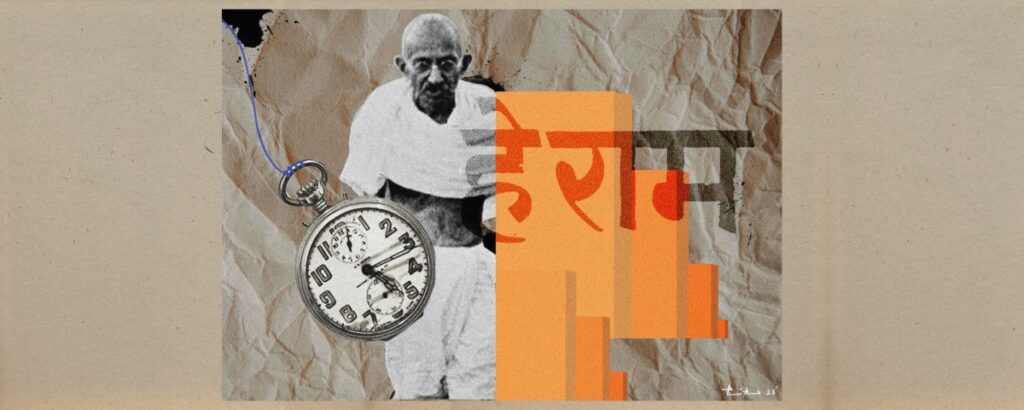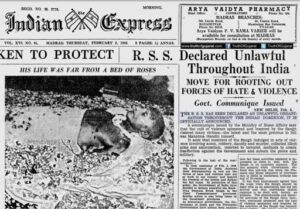Ira Bhaskar
Today, January 30, is the anniversary of Mahatma Gandhi’s assassination.
Suhas Palshikar has written very eloquently and poignantly of “our collective entry into an era of erasures” with the inauguration of the new Ram temple in Ayodhya on January 22. He discusses three such erasures that the thronging crowds at the temple and the mass hysteria of the moment have no time for.
The first erasure, on the foundations of which the new Ram temple has been inaugurated, is that of plurality – both of the multiple Ram traditions that enriched India as well as the plurality of religious and spiritual traditions that constitute India as well as Hinduism.
The second erasure is that of the constitutional legitimacy, history, reality and the dream of coexistence.
And the third erasure is that of the “collective amnesia” of December 6, 1992, of the criminal destruction of the Babri Masjid, which the Supreme Court also admitted in its judgement on the Ayodhya dispute while handing over the land on which the mosque stood to the Ram Janmabhoomi trust for the building of a new Ram temple.
While the new Ram temple at Ayodhya embodies all these erasures I would like to focus on one that Palshikar has mentioned – that of Gandhi and of Gandhi’s Ram. Like his Ram, the gentle, compassionate, loving one, Gandhi, was one who embraced people of different faiths and who was an epitome of the play of ethical values in public life. Whereas the idol of the child Ram that has been installed in the sanctum sanctorum of the new Ram temple is that of a chubby young boy with a beatific smile, the discourse surrounding this event is a majoritarian triumphalist one of victory over centuries of victimhood in which Ram is the symbolic centre of a new Hindu India: muscular, aggressive, supremacist.
This India has been born and is now poised for greatness as a nation, in Prime Minister Modi’s words, as “a strong, capable, grand and divine India” for “the next thousand years.” The implications of this statement and the makeover of the nation that has been imagined in the image of the new Ram is worrying to say the least.
As a devout Ram bhakt, Gandhi’s idea of Ram and of Ram Rajya was a completely different one from the exclusionist and majoritarian Hindutva one that we see in circulation today. Gandhi’s Ram was a benevolent leader whose “ moral quality and habitual adherence to truth” were key for the realization of the peace, plenty and harmony of an imagined Ram Rajya. Unlike Gandhi’s imagining of the new modern nation as one based on “Hindu and Muslim unity” which was for him “the cornerstone of swaraj,” the Hindutva project from the 1980s onwards transformed Ram into a virulent crusader of the rights of the Hindus against the minorities. In contrast, Gandhi stood for “minority rights, religious freedom, justice and forgiveness” and is one who sacrificed his life for communal amity.
It is this contrast in values between Gandhi and Hindutva forces and the symbolic contest of rights over the meaning, value and mobilising of the figure of Ram that Kamal Haasan’s Hey Ram (2000) is concerned with. While the last words of Gandhi address his personal God, in the film, it is also a cry of dismay at the atrocities committed in his God’s name that Ram would never have accepted. The cry is also a conscience raiser and can be seen as poignantly suggestive of how we have killed the Ram within us by becoming complicit with Hindutva ideological forces.
The cry thus designates both “the horror” of the outrages man can commit on man and also constitutes an appeal to bring those “horrors” to an end.
While the idol of the child God installed in the new Ram temple cannot be associated with the horrors mentioned above, and will elicit a protective, almost maternal love from his devotees, the forces unleashed by his coming to occupy the temple have already caused a trail of destruction and violence as some cadres of Hindutva regimes go about wreaking havoc.
In the immediate aftermath of the inauguration, these forces have burnt and destroyed houses and properties of Muslims, violently disrupted programmes that remember the demolition of the Babri Masjid and in intentionally provocative and humiliating gestures have challenged and dared Muslims by playing songs of victory outside a mosque.
I would like to use another film example – that culminates in the inauguration of a new Ram temple to illustrate the manner in which communal violence – physical, emotional and psychological – impacts the lives of Muslims on an everyday level. In Zaigham Imam’s 2019 film Nakkash, Allah Rakha is a sculptor and engraver who has spent his life engraving the walls of temples in Benaras and nearby areas. This is a profession that is hereditary and he has learnt the art from his father. The film traces the communal tensions that build up in the city before an election, while Allah Rakha remains dedicated to completing the gold engraved wall of the sanctum sanctorum of a Ram temple with beautiful idols of Ram, Lakshman and Sita.
Ironically on the occasion of Ram Navami, as the consecration of the idols in the temple takes place, the violent ugliness of the disease of fundamentalism and the politics of religion negates the possibilities of co-existence. As he attempts to make his way to the temple for the pran pratishtha, Allah Rakha is surrounded by a group of Hindu goons, the chief among whom, the cynical Hindutva politician, Munna Bhaiyya, deploys a trishul to destroy the life of the one who embodies the spirit of mutual respect, tolerance and love. Cruelly stabbing Allah Rakha with the trishul several times, Munna’s violent mobilisation of the symbol of Shiva to kill Allah Rakha, the Muslim devotee of Hindu gods, demonstrates that Hindutva has completely distorted the meanings of worship and devotion in Hinduism.
And as Allah Rakha’s life slowly ebbs away, the shanti mantras (the verses of peace) resonating from the temple after the unveiling of the beauty of the gods, whose home in the temple Allah Rakha has decorated so lovingly, is poignantly and tragically ironic.
The two film examples that I have used exhort us to think of the communalised reality of contemporary majoritarian India. Will it be possible for the past to be wiped out, the past that the present of the glitz and glamour of the new Ram temple has attempted to erase? Or, as the proverbial return of the repressed, will the ruins on which the new temple stands haunt this space?
And in the context of this year’s Republic Day and the anniversary of the assassination of Gandhi today, is it a majoritarian imagination of the nation that we want to uphold or an earlier idea of a plural, multi cultural polity? One cannot help but think at this critical moment of Paul Klee’s Angel of History who, as per Walter Benjamin’s elucidation, has his face turned to the past while a storm blows it towards the future.
The storm is that of progress, but the Angel sees only the growing pile of “wreckage upon wreckage” that the past has accumulated before it.
This is a distressing image and perhaps we need to accept collective guilt and atone the thousands dead of the Hindutva project, for the Ram Rajya that is being imagined is certainly not that of Gandhi’s.
(Ira Bhaskar retired as a professor at Jawaharlal Nehru University in March 2023. Courtesy: The Wire.)
❈ ❈ ❈
In another article also published in ‘The Wire’, Gandhi’s Ram Rajya Was No Hindu Raj, S.N. Sahu writes:
There has been a lot of talk about Ram Rajya following the consecration of the Ram temple in Ayodhya even as the slogan ‘Jai Shri Ram’ is being chanted by thugs unleashing violence against mosques, churches and Indians following Islam and Christianity. Gandhi’s last words when shot at by a Hindu fanatic on this day in 1948 were ‘Hey Ram’ and he would have reacted the same way at what is happening today in the name of Ram.
In the context of the Jai Shri Ram slogan so aggressively and menacingly recited on several occasions, it is instructive to recall Gandhi’s advice about such slogans. In an article written in the Harijan on August 9, 1942, he referred to the letter he received from someone who informed him that members of the Rashtriya Swayam Sevak Sangh (RSS) in their morning rallies were reciting slogans against Muslims. Gandhi wrote about 3,000 members of RSS organising a daily lathi drill followed by reciting the slogan, “Hindustan belongs to Hindus and to nobody else.”
He then referred to the brief discourse accompanying those menacing utterances. During the discourse the speakers used to say: “Drive out the English first and then we shall subjugate the Muslims. If they do not listen, we shall kill them.” “Taking the evidence at its face value”, Gandhi sharply remarked, “the slogan is wrong and the central theme of the discourse is worse”. Stating that India “….belongs to Parsis, Beni Israels, to Indian Christians, Muslims and other non-Hindus as much as to Hindus”, Gandhi firmly rejected the idea of an India anchored in any one faith and categorically affirmed, “Free India will be no Hindu raj, it will be Indian raj based not on the majority of any religious sect or community but on the representatives of the whole people without distinction of religion”. He then appealed to the lathi wielding RSS activists to avoid reciting such violent slogans.
While observing the solemn occasion of Mahatma Gandhi’s martyrdom day on 30th January 2024 we need to be mindful of those words which are more relevant in the present day when the Jai Shri Ram slogan is being used against others pursuing faiths different from those of the majority community in India.
Speaking in Bhopal on 10th September 1929, Gandhi made it very clear that his idea of Ram Rajya was not theocratic in nature and scope and remarked, ‘By Ramarajya’ I do not mean Hindu Raj”. “I mean by ‘Ramarajya’ the Divine Raj, the Kingdom of God… For me Rama and Rahim are one and the same deity”. Rahim, or the merciful, is one of the synonyms of Allah.
He added, “I acknowledge no other god but the one god of Truth and righteousness”. “Whether the Rama of my imagination ever lived or not on this earth, the ancient ideal of Ram Rajya is undoubtedly one of true democracy in which the meanest citizen could be sure of swift justice without an elaborate and costly procedure,” he added.
His pluralistic nature of Ram Rajya stands in sharp contrast to the shouting for Hindu Rashtra by several of those who attended the consecration ceremony organised in Ayodhya on January 22, 2024.
That idea of Hindu Rashtra was rejected by Gandhi as early as 1929 and it is tragic that in a meeting attended by Prime Minister Modi, this divisive slogan was raised and none of the leaders attending that event even raised any objections against it.
(S.N. Sahu Served as Officer on Special Duty to President of India K.R. Narayanan.)




